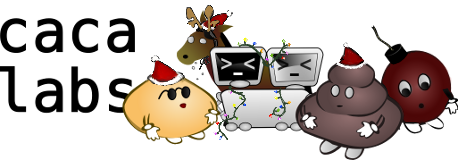| 15 | | [[Image(source:/web/trunk/static/study/out/lena2-1-1.png, |
| 16 | | [[Image(source:/web/trunk/static/study/out/grad2-1-1.png, |
| | 15 | [[Image(source:/web/trunk/static/study/out/lena2-1-1.png,class="inline",alt="25%, 50% and 75% halftoning")]] |
| | 16 | [[Image(source:/web/trunk/static/study/out/grad2-1-1.png,class="inline",alt="25%, 50% and 75% halftoning gradient")]] |
| 45 | | [[Image(source:/web/trunk/static/study/fig2-3-1b.png, |
| 46 | | [[Image(source:/web/trunk/static/study/out/lena2-3-0.png, |
| 47 | | [[Image(source:/web/trunk/static/study/out/grad2-3-0.png, |
| | 45 | [[Image(source:/web/trunk/static/study/fig2-3-1b.png,class="matrix",alt="tiled dither matrix")]] |
| | 46 | [[Image(source:/web/trunk/static/study/out/lena2-3-0.png,class="inline",alt="2×2 Bayer dithering")]] |
| | 47 | [[Image(source:/web/trunk/static/study/out/grad2-3-0.png,class="inline",alt="2×2 Bayer dithering gradient")]] |
| 55 | | [[Image(source:/web/trunk/static/study/out/fig2-3-2.png, |
| 56 | | [[Image(source:/web/trunk/static/study/out/lena2-3-1.png, |
| 57 | | [[Image(source:/web/trunk/static/study/out/grad2-3-1.png, |
| | 55 | [[Image(source:/web/trunk/static/study/out/fig2-3-2.png,class="matrix",alt="4×4 Bayer matrix")]] |
| | 56 | [[Image(source:/web/trunk/static/study/out/lena2-3-1.png,class="inline",alt="4×4 Bayer dithering")]] |
| | 57 | [[Image(source:/web/trunk/static/study/out/grad2-3-1.png,class="inline",alt="4×4 Bayer dithering gradient")]] |
| 61 | | [[Image(source:/web/trunk/static/study/out/fig2-3-2b.png, |
| 62 | | [[Image(source:/web/trunk/static/study/out/lena2-3-1b.png, |
| 63 | | [[Image(source:/web/trunk/static/study/out/grad2-3-1b.png, |
| | 61 | [[Image(source:/web/trunk/static/study/out/fig2-3-2b.png,class="matrix",alt="4×4 Bayer matrix")]] |
| | 62 | [[Image(source:/web/trunk/static/study/out/lena2-3-1b.png,class="inline",alt="4×4 Bayer dithering")]] |
| | 63 | [[Image(source:/web/trunk/static/study/out/grad2-3-1b.png,class="inline",alt="4×4 Bayer dithering gradient")]] |
| 67 | | [[Image(source:/web/trunk/static/study/out/fig2-3-3.png, |
| 68 | | [[Image(source:/web/trunk/static/study/out/lena2-3-2.png, |
| 69 | | [[Image(source:/web/trunk/static/study/out/grad2-3-2.png, |
| | 67 | [[Image(source:/web/trunk/static/study/out/fig2-3-3.png,class="matrix",alt="4×4 cluster dot matrix")]] |
| | 68 | [[Image(source:/web/trunk/static/study/out/lena2-3-2.png,class="inline",alt="4×4 cluster dot dithering")]] |
| | 69 | [[Image(source:/web/trunk/static/study/out/grad2-3-2.png,class="inline",alt="4×4 cluster dot dithering gradient")]] |
| 73 | | [[Image(source:/web/trunk/static/study/out/fig2-3-3b.png, |
| 74 | | [[Image(source:/web/trunk/static/study/out/lena2-3-2b.png, |
| 75 | | [[Image(source:/web/trunk/static/study/out/grad2-3-2b.png, |
| | 73 | [[Image(source:/web/trunk/static/study/out/fig2-3-3b.png,class="matrix",alt="4×4 cluster dot matrix")]] |
| | 74 | [[Image(source:/web/trunk/static/study/out/lena2-3-2b.png,class="inline",alt="4×4 cluster dot dithering")]] |
| | 75 | [[Image(source:/web/trunk/static/study/out/grad2-3-2b.png,class="inline",alt="4×4 cluster dot dithering gradient")]] |
| 79 | | [[Image(source:/web/trunk/static/study/out/fig2-3-4.png, |
| 80 | | [[Image(source:/web/trunk/static/study/out/lena2-3-3.png, |
| 81 | | [[Image(source:/web/trunk/static/study/out/grad2-3-3.png, |
| | 79 | [[Image(source:/web/trunk/static/study/out/fig2-3-4.png,class="matrix",alt="4×4 cluster dot matrix")]] |
| | 80 | [[Image(source:/web/trunk/static/study/out/lena2-3-3.png,class="inline",alt="4×4 cluster dot dithering")]] |
| | 81 | [[Image(source:/web/trunk/static/study/out/grad2-3-3.png,class="inline",alt="4×4 cluster dot dithering gradient")]] |
| 91 | | [[Image(source:/web/trunk/static/study/out/lena2-4-1.png, |
| 92 | | [[Image(source:/web/trunk/static/study/out/grad2-4-1.png, |
| | 91 | [[Image(source:/web/trunk/static/study/out/lena2-4-1.png,class="inline",alt="4×4 Bayer dithering, gaussian perturbation")]] |
| | 92 | [[Image(source:/web/trunk/static/study/out/grad2-4-1.png,class="inline",alt="4×4 Bayer dithering, gaussian perturbation gradient")]] |
| 98 | | [[Image(source:/web/trunk/static/study/fig2-4-1.png, |
| 99 | | [[Image(source:/web/trunk/static/study/out/lena2-4-2.png, |
| 100 | | [[Image(source:/web/trunk/static/study/out/grad2-4-2.png, |
| | 98 | [[Image(source:/web/trunk/static/study/fig2-4-1.png,class="matrix",alt="four 3×3 dispersed dot matrices")]] |
| | 99 | [[Image(source:/web/trunk/static/study/out/lena2-4-2.png,class="inline",alt="random Bayer matrix dithering")]] |
| | 100 | [[Image(source:/web/trunk/static/study/out/grad2-4-2.png,class="inline",alt="random Bayer matrix dithering gradient")]] |
| 106 | | [[Image(source:/web/trunk/static/study/fig2-5-1.png, |
| 107 | | [[Image(source:/web/trunk/static/study/out/lena2-5-1.png, |
| 108 | | [[Image(source:/web/trunk/static/study/out/grad2-5-1.png, |
| 109 | | |
| 110 | | [[Image(source:/web/trunk/static/study/fig2-5-2.png, |
| 111 | | [[Image(source:/web/trunk/static/study/out/lena2-5-2.png, |
| 112 | | [[Image(source:/web/trunk/static/study/out/grad2-5-2.png, |
| 113 | | |
| 114 | | [[Image(source:/web/trunk/static/study/fig2-5-3.png, |
| 115 | | [[Image(source:/web/trunk/static/study/out/lena2-5-3.png, |
| 116 | | [[Image(source:/web/trunk/static/study/out/grad2-5-3.png, |
| 117 | | |
| 118 | | [[Image(source:/web/trunk/static/study/fig2-5-4.png, |
| 119 | | [[Image(source:/web/trunk/static/study/out/lena2-5-4.png, |
| 120 | | [[Image(source:/web/trunk/static/study/out/grad2-5-4.png, |
| | 106 | [[Image(source:/web/trunk/static/study/fig2-5-1.png,class="matrix",alt="cross dither tile")]] |
| | 107 | [[Image(source:/web/trunk/static/study/out/lena2-5-1.png,class="inline",alt="cross dithering")]] |
| | 108 | [[Image(source:/web/trunk/static/study/out/grad2-5-1.png,class="inline",alt="cross dithering gradient")]] |
| | 109 | |
| | 110 | [[Image(source:/web/trunk/static/study/fig2-5-2.png,class="matrix",alt="hex dither tile")]] |
| | 111 | [[Image(source:/web/trunk/static/study/out/lena2-5-2.png,class="inline",alt="hex dithering")]] |
| | 112 | [[Image(source:/web/trunk/static/study/out/grad2-5-2.png,class="inline",alt="hex dithering gradient")]] |
| | 113 | |
| | 114 | [[Image(source:/web/trunk/static/study/fig2-5-3.png,class="matrix",alt="square dither tile")]] |
| | 115 | [[Image(source:/web/trunk/static/study/out/lena2-5-3.png,class="inline",alt="square dithering")]] |
| | 116 | [[Image(source:/web/trunk/static/study/out/grad2-5-3.png,class="inline",alt="square dithering gradient")]] |
| | 117 | |
| | 118 | [[Image(source:/web/trunk/static/study/fig2-5-4.png,class="matrix",alt="hex2 dither tile")]] |
| | 119 | [[Image(source:/web/trunk/static/study/out/lena2-5-4.png,class="inline",alt="hex2 dithering")]] |
| | 120 | [[Image(source:/web/trunk/static/study/out/grad2-5-4.png,class="inline",alt="hex2 dithering gradient")]] |
| 128 | | [[Image(source:/web/trunk/static/study/fig2-6-1.png, |
| 129 | | [[Image(source:/web/trunk/static/study/out/lena2-6-1.png, |
| 130 | | [[Image(source:/web/trunk/static/study/out/grad2-6-1.png, |
| 131 | | |
| 132 | | [[Image(source:/web/trunk/static/study/fig2-6-2.png, |
| 133 | | [[Image(source:/web/trunk/static/study/out/lena2-6-2.png, |
| 134 | | [[Image(source:/web/trunk/static/study/out/grad2-6-2.png, |
| 135 | | |
| 136 | | [[Image(source:/web/trunk/static/study/fig2-6-3.png, |
| 137 | | [[Image(source:/web/trunk/static/study/out/lena2-6-3.png, |
| 138 | | [[Image(source:/web/trunk/static/study/out/grad2-6-3.png, |
| | 128 | [[Image(source:/web/trunk/static/study/fig2-6-1.png,class="matrix",alt="4-wise cross dither tile")]] |
| | 129 | [[Image(source:/web/trunk/static/study/out/lena2-6-1.png,class="inline",alt="4-wise cross dithering")]] |
| | 130 | [[Image(source:/web/trunk/static/study/out/grad2-6-1.png,class="inline",alt="4-wise cross dithering gradient")]] |
| | 131 | |
| | 132 | [[Image(source:/web/trunk/static/study/fig2-6-2.png,class="matrix",alt="3-wise hex dither tile")]] |
| | 133 | [[Image(source:/web/trunk/static/study/out/lena2-6-2.png,class="inline",alt="3-wise hex dithering")]] |
| | 134 | [[Image(source:/web/trunk/static/study/out/grad2-6-2.png,class="inline",alt="3-wise hex dithering gradient")]] |
| | 135 | |
| | 136 | [[Image(source:/web/trunk/static/study/fig2-6-3.png,class="matrix",alt="4-wise square dither tile")]] |
| | 137 | [[Image(source:/web/trunk/static/study/out/lena2-6-3.png,class="inline",alt="4-wise square dithering")]] |
| | 138 | [[Image(source:/web/trunk/static/study/out/grad2-6-3.png,class="inline",alt="4-wise square dithering gradient")]] |
| 142 | | [[Image(source:/web/trunk/static/study/out/fig2-6-4.png, |
| 143 | | [[Image(source:/web/trunk/static/study/out/lena2-6-4.png, |
| 144 | | [[Image(source:/web/trunk/static/study/out/grad2-6-4.png, |
| | 142 | [[Image(source:/web/trunk/static/study/out/fig2-6-4.png,class="matrix",alt="twin dragon dither tile")]] |
| | 143 | [[Image(source:/web/trunk/static/study/out/lena2-6-4.png,class="inline",alt="twin dragon dithering")]] |
| | 144 | [[Image(source:/web/trunk/static/study/out/grad2-6-4.png,class="inline",alt="twin dragon dithering gradient")]] |
| 148 | | [[Image(source:/web/trunk/static/study/fig2-6-5.png, |
| 149 | | [[Image(source:/web/trunk/static/study/out/lena2-6-5.png, |
| 150 | | [[Image(source:/web/trunk/static/study/out/grad2-6-5.png, |
| 151 | | |
| 152 | | [[Image(source:/web/trunk/static/study/fig2-6-6.png, |
| 153 | | [[Image(source:/web/trunk/static/study/out/lena2-6-6.png, |
| 154 | | [[Image(source:/web/trunk/static/study/out/grad2-6-6.png, |
| | 148 | [[Image(source:/web/trunk/static/study/fig2-6-5.png,class="matrix",alt="3-way hex2 dither tile")]] |
| | 149 | [[Image(source:/web/trunk/static/study/out/lena2-6-5.png,class="inline",alt="3-way hex2 dithering")]] |
| | 150 | [[Image(source:/web/trunk/static/study/out/grad2-6-5.png,class="inline",alt="3-way hex2 dithering gradient")]] |
| | 151 | |
| | 152 | [[Image(source:/web/trunk/static/study/fig2-6-6.png,class="matrix",alt="9-way hex2 dither tile")]] |
| | 153 | [[Image(source:/web/trunk/static/study/out/lena2-6-6.png,class="inline",alt="9-way hex2 dithering")]] |
| | 154 | [[Image(source:/web/trunk/static/study/out/grad2-6-6.png,class="inline",alt="9-way hex2 dithering gradient")]] |
| 199 | | [[Image(source:/web/trunk/static/study/out/lena2-7-1.png, |
| 200 | | [[Image(source:/web/trunk/static/study/out/grad2-7-1.png, |
| 201 | | [[Image(source:/web/trunk/static/study/out/lena2-7-2.png, |
| 202 | | [[Image(source:/web/trunk/static/study/out/grad2-7-2.png, |
| | 197 | [[Image(source:/web/trunk/static/study/out/lena2-7-1.png,class="inline",alt="14×14 void and cluster dithering")]] |
| | 198 | [[Image(source:/web/trunk/static/study/out/grad2-7-1.png,class="inline",alt="14×14 void and cluster dithering gradient")]] |
| | 199 | [[Image(source:/web/trunk/static/study/out/lena2-7-2.png,class="inline",alt="25×25 void and cluster dithering")]] |
| | 200 | [[Image(source:/web/trunk/static/study/out/grad2-7-2.png,class="inline",alt="25×25 void and cluster dithering gradient")]] |
